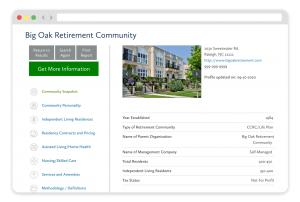With Tax Day upon us, we are once again sharing some basic information about potentially tax-deductible retirement community expenses. If you or a loved one is considering a senior living move to a retirement community, it’s important to understand exactly what is, and is not, a related deductible expense. You of course don’t want to miss out on potential tax savings … nor do you want to incur tax penalties for taking unauthorized deductions.
Entry fee Tax deductions and retirement communities
Continuing care retirement communities (also called CCRCs or life plan communities), offer not only independent living residences, but also services spanning a continuum of care; often including assisted living, memory care, and skilled nursing. New residents of CCRCs typically live fully or mostly independently and may still quite active in many cases, but a part of their CCRC contract provides for access to these care services if and when needed.
Many residents of CCRCs can deduct a sizable portion of their entry fee, as well as their monthly fees. But why are some CCRC fees tax deductible?
It’s because the financial structure of a CCRC is typically such that a fairly sizable portion of a new resident’s CCRC entry fee (if applicable) and a resident’s monthly service fee (MSF) is considered a “pre-paid medical expense.” Herein lies the main reason for the deductibility of part of these fees. (See IRS Publication 502: Medical and Dental Expenses for complete details). Importantly, this deduction may apply even when a CCRC resident is not currently receiving any healthcare services from the community. In other words, even when the resident is living independently, they may still be able to take advantage of this deduction.
We find that many older adults are not fully aware of the tax deductions that may be available to residents of CCRCs. However, it is essential to understand that the availability and size of any CCRC tax deduction depend in large part on:
- The type of CCRC residency contract the resident has with the community
- The specific entry and/or monthly service fees assessed by the community
- Whether you itemize or take the standard deduction on your taxes. (The deduction is not applicable if you take the standard deduction.)
>> Related: Are CCRC Tax Deductions Only Available at Non-Profit CCRCs?
Tax deductions based on CCRC contract type
The first thing to understand is the various types of residency contracts offered by CCRCs in order to determine the potential tax deductibility of entry and/or monthly service fees.
Lifecare contracts (Type A)
A life care/Type A contract requires higher entry or monthly service fees, but in return, most healthcare services — including assisted living and skilled nursing — are covered with little or no increase in cost over time. This offers long-term cost predictability by essentially prepaying for most future care needs. However, the trade-off is that residents may pay for services they never use. For couples, the benefit of lifecare may be even greater because both spouses may save money on the cost of care.
An equalized rate lifecare contract is a variation of the Type A/lifecare contract wherein residents pay a set rate for healthcare services — often tied to the cost of a specific independent living unit — if and when they move to assisted living or skilled nursing care. Unlike the traditional Lifecare contract, the monthly service fee for an equalized rate life care contract may increase or may decrease depending on the resident’s original living unit. For couples, each person pays the equalized rate individually if both require care, rather than continuing the joint monthly rate.
Tax implications: Typically, a Type A/lifecare contract offers the most substantial deductions, as a significant portion of the fee is considered prepaid medical expenses.
Modified contracts (Type B)
Similar to the Type A contract, the modified/Type B contract usually offers some future healthcare coverage, such as discounted rates (e.g., 20–30% off) or a set number of “free” days in assisted living or skilled nursing care. After those benefits are used, however, the resident pays the full market rate for care services.
Terms vary with Type B contracts — for example, some contracts combine discounts with allotted days — and it’s important for couples to understand how care-related benefits apply to each person.
Tax implications: Modified/ Type B contacts may also provide deductions for prepayment of healthcare expenses, though the deduction is usually at a lower rate than Type A contracts.
Fee-for-service contracts (Type C)
Fee-for-service contracts have lower entry and monthly service fees but require residents to pay full market rates for assisted living or skilled nursing care if needed. Some offer à la carte options for services in independent living. While there’s no upfront payment for future care, residents bear the full financial risk of long-term care costs.
Tax implications: Deductions for prepayment of healthcare expenses are less common and may be limited because nursing care expenses are paid at the time of service.
Rental contacts
Rental CCRC contracts typically have no entry fee or only a small community fee, with month-to-month agreements. Monthly service fees are generally higher, and residents pay full market rates for healthcare. These contracts often don’t guarantee priority access to care services, and over time — especially for couples — lifetime costs can exceed those of entry-fee communities, depending on the level and length of care needed.
Tax implications: Deductions for prepayment of healthcare expenses are less common and may be limited because nursing care expenses are paid at the time of service.
Equity/co-op contract
In equity or co-op CCRCs, residents own their unit (or shares in a co-op) but still pay monthly service fees for amenities and maintenance. Healthcare is typically billed at full market rates. In true ownership models, the property can be inherited by an age-qualified heir. Otherwise, monthly service fees may continue until the unit is sold to an age-qualified buyer. Some versions of this type of CCRC aren’t full ownership; rather, operators retain ownership but share resale proceeds with residents or their heirs.
Tax implications: Deductions for prepayment of healthcare expenses are less common and may be limited.
>> Related: Learn more about the different types of CCRC contracts.
Key considerations for retirement community tax deductions
While a comprehensive review of tax deductions related to retirement communities (and CCRCs in particular) is beyond the scope of this blog post, the following are important points to keep in mind:
- Current utilization of healthcare services is not required in order to qualify for a tax deduction. Because a portion of a CCRC’s entry fee and/or monthly service fee is considered prepayment for future healthcare costs, a CCRC resident may be eligible for a medical expense tax deduction even if they are living independently and not actively receiving healthcare services.
- Only the non-refundable portion of an entry fee qualifies for a medical expense deduction. If a previously deducted portion of the entry fee is later refunded, it may be considered taxable income in the year the refunded amount is received. It’s best to only take the deduction as it applies to the non-refundable part of the entry fee.
- Under current IRS guidelines (2024) regarding medical expense thresholds, individuals can deduct unreimbursed medical expenses that exceed 7.5% of their adjusted gross income (AGI). This applies regardless of age as of 2024. Therefore, any portion of entry or monthly service fees considered a prepaid medical expense may be combined with other qualifying medical costs to determine total deductible expenses.
- Tax deductions are most common for residents with Type A (lifecare) and Type B (modified) contracts, as these typically include a healthcare expense prepayment component. In some cases, residents under a Type C (fee-for-service), equity, or co-op contract may also qualify for a limited deduction, but this is less common.
- Each CCRC may use a different methodology, often developed by its financial officer or auditor, to determine what portion of entry and/or monthly service fees is attributable to medical care. As a rough estimate, one might typically expect the deduction to be around 30% to 40% of the non-refundable entry fee and monthly service fees, but this can vary significantly by community.
- If a third-party (such as adult children or others) contributes their own money to pay a portion of a CCRC resident’s entrance fee, the third-party may also be eligible to claim a tax deduction. However, eligibility depends on factors such as the level of financial support provided and whether the resident qualifies as a dependent of the third party.
>> Related: Financial Considerations of CCRC Fee Tax Deductions
For more detailed information on whether a retirement community entry fee is tax deductible, refer to IRS Publication 502: Medical and Dental Expenses, which provides comprehensive guidelines on medical and dental expenses.
And just as important: Please note that tax laws can and do change. It is therefore essential to consult an experienced CPA or tax professional, or refer to official IRS publications for the most current information.
Original post date: July 1st, 2013; updated April 14, 2025. Edited on April 14, 2025 to clarify that the deduction is only available if the tax-payer is itemizing on their tax return instead of taking the standard deduction.

FREE Detailed Profile Reports on CCRCs/Life Plan Communities
Search Communities






